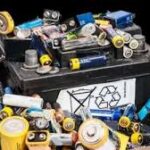As we move towards an electrified future, the demand for lithium-ion batteries (LIB) has surged. From electric vehicles (EVs) to renewable energy storage, these batteries are central to our technological advancements. However, this growing reliance on lithium-ion batteries presents significant challenges—most notably the need for efficient and sustainable lithium battery reusing and recycling. The world faces a pressing issue of mineral scarcity and environmental impact, which calls for better strategies to handle the lifecycle of these essential batteries. Fortunately, innovation is paving the way for solutions that not only meet the rising demand for these materials but also support a circular economy.
A Surge in Lithium-Ion Battery Demand
The market for lithium-ion batteries is expanding rapidly. By 2030, analysts predict that more than half a million EV batteries will be retired annually, equating to over 2 million metric tons of batteries per year. Despite the promise of electric vehicles and renewable energy storage, this growing fleet of batteries will eventually need to be processed through recycling and reuse channels. However, the process of recycling and reusing lithium-ion batteries has proven to be challenging and expensive.
Currently, much of the world’s lithium is sourced from mining operations, which are energy-intensive, environmentally taxing, and often controversial due to their social and ecological impacts. This has led to significant research into the viability of lithium battery reusing and recycling to address mineral shortages and reduce the environmental footprint of production. The key to unlocking this potential is optimizing battery recovery processes and innovating in battery recycling technologies.
The Promise of Reusing and Recycling Lithium-Ion Batteries
A critical aspect of lithium-ion battery recycling is the recovery of lithium and other key minerals such as nickel, cobalt, and manganese. These minerals are used in the production of battery cathodes, which are crucial for the performance of EVs and energy storage systems. The price volatility of these minerals has been a major challenge for the battery industry, with costs fluctuating by as much as 300% in a single year. This has resulted in an economic incentive to recycle these materials, thereby stabilizing supply chains and reducing dependence on newly mined resources.
One significant development in lithium-ion battery recycling has been the emergence of direct recycling methods. Unlike traditional processes that break down the battery and lose valuable components, direct recycling keeps the cathode structure intact and refines it for reuse. Researchers have found that recycled cathode materials produced through direct recycling maintain the same, if not better, performance characteristics than new cathodes, including improved lifespan and faster charging times. This breakthrough opens the door to more efficient and sustainable ways to recycle lithium-ion battery precursors, such as cobalt and nickel, thus lowering costs and environmental impact.
Future Insights and Policy Developments
By 2030, the demand for lithium-ion batteries is expected to increase tenfold, underscoring the urgent need for a circular battery supply chain. However, the challenges associated with recycling and reusing lithium-ion batteries are far from resolved. One barrier is the complexity of battery designs, which limit the ability to efficiently repurpose and extract valuable materials. As battery technologies evolve and become more integrated with proprietary management systems, the task of reusing and recycling these batteries becomes more difficult.
In response to these challenges, several innovative methods are being explored. For instance, the development of automated disassembly processes for battery packs could significantly reduce the time and cost associated with recycling, while increasing the purity of recovered materials. Additionally, governments and organizations are starting to establish policies to encourage battery reuse and recycling. California, for example, is leading the way with legislation aimed at ensuring that 100% of EV batteries sold in the state are recycled or reused at the end of their life cycle.
The shift toward domestic supply chains for lithium-ion battery precursors could further reduce reliance on overseas mining operations. As domestic recycling technologies and infrastructures develop, countries will be able to reclaim more materials locally, reducing the carbon footprint associated with the global supply chain.
The Path to a Sustainable Future
At LOHUM, we are at the forefront of advancing lithium-ion battery recycling and lithium battery reusing and recycling technologies. Our commitment to the sustainable management of lithium-ion battery lifecycles includes a focus on second-life battery applications, where retired EV batteries can be repurposed for stationary energy storage. This innovative approach extends the useful life of batteries, reduces the demand for new materials, and supports the transition to cleaner energy systems.
As the battery market continues to evolve, lithium-ion battery recycling will play a pivotal role in supporting the global push for electrification. By adopting best practices in material recovery, enhancing the performance of recycled components, and supporting sustainable policies, we can build a more resilient and environmentally friendly future. Through continued collaboration between industry leaders, governments, and research institutions, we can pave the way for a circular economy in the battery industry.
In conclusion, the future of lithium-ion battery recycling and lithium battery reusing and recycling holds immense promise. By investing in advanced recycling technologies, strengthening policy frameworks, and fostering innovation, we can address both the environmental and economic challenges posed by the growing demand for electric vehicles and renewable energy storage. At LOHUM, we remain committed to leading the way in this critical area, ensuring that the energy solutions of tomorrow are both sustainable and economically viable.
Visit us at: Recycled Li-ion battery materials
Originally published on: Blogger

